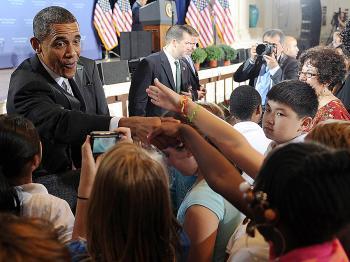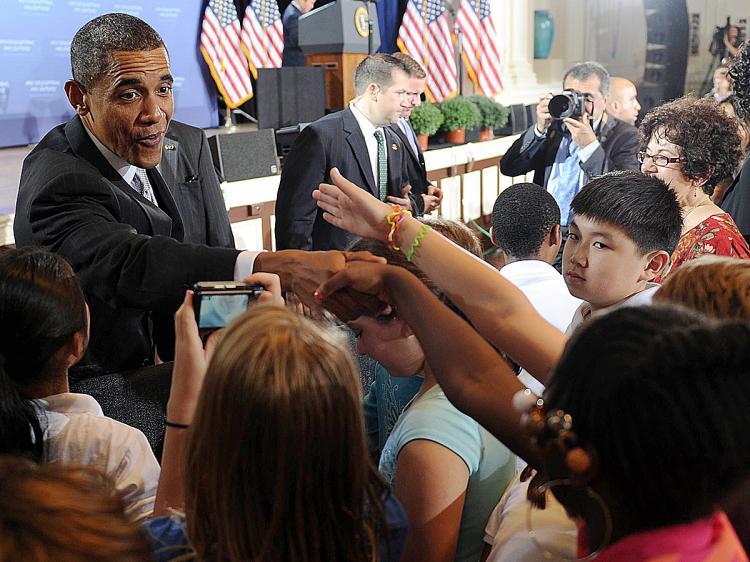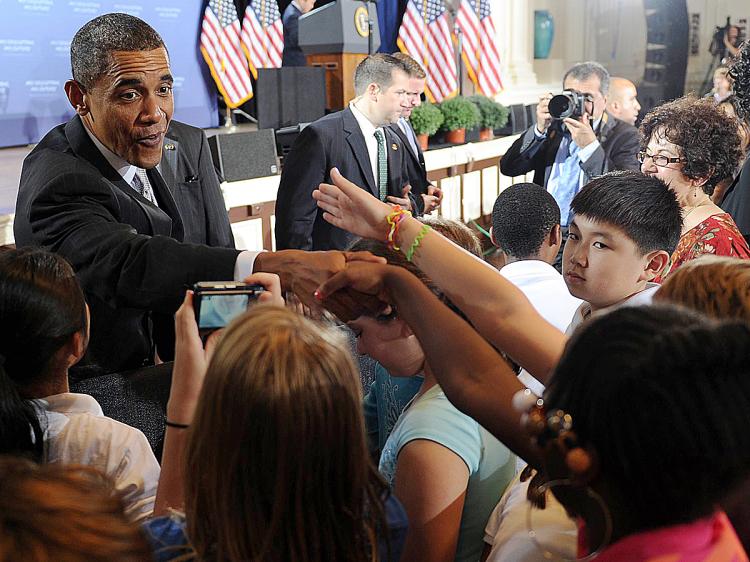NBC News kicked off the Education Nation Summit on Monday at Rockefeller Center, bringing together experts and policymakers in education to discuss a plethora of problems faced by the nation’s schools, and potential solutions.
“National statistics show that 68 percent of eighth-graders cannot read at their grade level; American students rank 25th in math and 21st in science compared to 30 other industrialized countries,” according to the summit’s press release.
As Education Nation commenced in New York, President Obama discussed education reform with Matt Laurer of the “Today Show” at the White House.
“We can’t spend our way out of it. I think that when you look at the statistics, the fact is that our per-pupil spending has gone up during the last couple of decades even as results have gone down,” said Obama.
The funding must be combined with key reforms, particularly extending the school year by a month and raising standards in the teaching profession, said the president. He pointed out that students in other countries, like India, go to school for an extra month, which gives them an advantage.
At the summit opener, Bloomberg echoed these reforms and said that highly qualified, distinguished teachers will receive bonuses to teach at low-performing schools. The bonuses will be funded by $36 million received as a Teacher Incentive Fund grant from the U.S. Department of Education, he announced.
“By rewarding teachers who make a real difference, bringing technology into our classrooms and creating partnerships with the private sector, we will build upon the improvements we have made over the last eight years and give New York City children the future they deserve,” said Bloomberg.
Bloomberg also wants public schools to work more with the private sector. He introduced a school to be developed in partnership with IBM. The school, which covers grades 9 through 12 and the first two years of college, will allow students to graduate with an Associate’s Degree and possibly get employment with IBM.
Education Becoming Hot Topic
America’s schools are becoming an increasingly hot topic. At the summit, Facebook founder Mark Zuckerman, discussed his donation of $100 million to improve schools in Newark, N.J. He made the announcement of his donation on Oprah last Friday.
The recent release of a new documentary, “Waiting for Superman” from Davis Guggenheim, the director of “An Inconvenient Truth,” is also fueling debate about America’s schools.
Only in select theaters for now, Guggenheim’s new film draws attention to the state of education in America, in a strikingly similar way to how “An Inconvenient Truth” drew attention to the environment.
“A hidden catastrophe is spreading quietly, insidiously through our nation’s cities, towns, and communities,” according to the film’s synopsis.
The film documents the experiences of a first-grader from the Bronx and a kindergarten student from Harlem, among others. Geoffrey Canada, founder of the Harlem Children’s Fund, also makes an appearance.
Mr. Canada helped develop Promise Academy Charter Schools in Harlem, focused on improving education by extending the school year, promoting healthy living, and offering extra academic help on evenings and weekends.
According to a Daily News review by Josh Osterhout, Canada is a figure of hope in the film amidst the difficulties that education reform is shown to face.
Technology in the Classroom
A summit panel dedicated to technology in the classroom brought together developers, implementers, and sellers of educational technology.
NBC news anchor Lester Holt introduced the discussion by describing technology that some children are already using at school every day. For example, a teacher asks the class, “What is the capital of France?” The students’ responses are given electronically and instantly transformed into a pie chart, allowing her to see what percentage of the students know the answer to the question. If the percentage is high, she can move on, if it’s low, maybe she should spend some more time on the topic.
Milton Chen of the George Lucas Educational Foundation described “Intelligent Text,” that talks back to students, helping them out if they can’t understand a word. It might show a picture as a hint, or give the word in Spanish, Russian, French, whatever the student’s first language is.
Holt asked Chen what he had to say to those who claim “technology savvy kids are not necessarily smarter kids.”
“In most of those studies [used to support that point], the technology was not implemented well. Some of these studies look at technology that’s only actually being used about an hour a week. So the main factor in the impact of educational technology is actually—surprise—the teacher,” responded Chen.
The panel discussed how children are often more familiar with the use of technology than their teachers.
“There (will) be no broad use of technology in the schools until the teacher feels just as comfortable using the computer as she does using chalk. Now, (teachers) all feel comfortable using computers,” said Dick Robinson, CEO of Scholastic.
This comment was met with a scoff from audience member Jeanne Allen, president of the Center for Education Reform.
“Teachers may, like us, be able to use a computer. But they don’t know how to engage students in using technology a different way. It’s there for word processing; it’s there to browse the Web. It’s not there for learning. The comfort level might be a comfort (in which) they don’t mind having a computer around, or engaging a student to use it, but they aren’t really using it to deliver a teaching method,” she explained after the panel dispersed.
Though technology has the potential to improve education, there are certainly obstacles in applying it on a large scale.
“The development of an entire ecosystem takes multiple decades,“ explained Reed Hastings, CEO of Netflix,”But we’re seeing that the cost of putting a Web browser in front of a kid is dropping rapidly as netbooks and iPads and all kinds of technology are maturing and coming down in price.”
Kaitlynn Marrero, a junior at Palisade Preparatory School, remains skeptical about the benefits more technology would afford her in the classroom.
“Everyone’s just going to be glued to technology all day, whatever happened to going outside? I have some friends that won’t leave the computer, that’s why no one hangs out with them,” said Marrero.








Friends Read Free